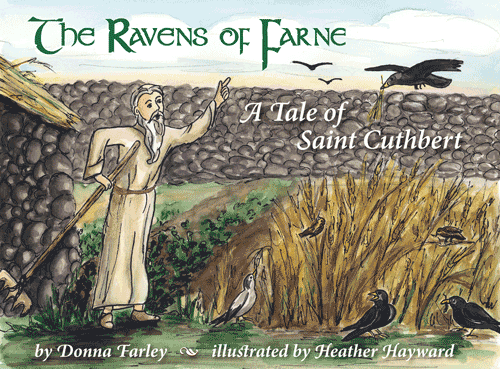Saint Cuthbert (c. 634 – 20 March 687) was a saint of the early Northumbrian church in the Celtic tradition. St. Cuthbert was perhaps of a noble family, and born in what are now the
Scottish Borders in the mid-630s, some ten years after the conversion of
King Edwin to Christianity in 627, which was
slowly followed by that of the rest of his people. He grew up near Melrose Abbey, a daughter-house of Lindisfarne, today in Scotland.
His course in life seems to have turned on an experience when he was tending sheep one night. Cuthbert saw lights in the sky that he interpreted to be an angel descending to earth and returning to heaven with the soul of St. Aidan of Lindisfarne, whom he found later to have died that evening, August 31, 651. Through this event he decided to go to the Melrose Abbey on the Tweed River and become a monk.
He seems to have done some military service prior to his monastic pursuits. He was quickly made guest-master at the new monastery at Ripon, soon after 655, but had to return with Eata to Melrose when Wilfrid was given the monastery instead. About 662, he was made prior at Melrose, and around 665 went as prior to Lindisfarne. In 684 he was made bishop of Lindisfarne but by late 686 resigned and returned to his hermitage as he felt he was about to die, although he was probably only in his early 50s.
He was a monk, bishop and hermit, associated with the monasteries of Melrose and Lindisfarne in what might loosely be termed the Kingdom of Northumbria in the Northeast of England. After his death he became one of the most important medieval saints of Northern England. St. Cuthbert is regarded as the patron saint of northern England. His feast day is celebrated March 20.
One children's book written on the life of St. Cuthburt is "The Ravens of Farne: A Tale Of St. Cuthbert" by Donna Farley. A live audio reading by Dr. Crissi Hart is also available from Ancient Faith Radio!
slowly followed by that of the rest of his people. He grew up near Melrose Abbey, a daughter-house of Lindisfarne, today in Scotland.
His course in life seems to have turned on an experience when he was tending sheep one night. Cuthbert saw lights in the sky that he interpreted to be an angel descending to earth and returning to heaven with the soul of St. Aidan of Lindisfarne, whom he found later to have died that evening, August 31, 651. Through this event he decided to go to the Melrose Abbey on the Tweed River and become a monk.
He seems to have done some military service prior to his monastic pursuits. He was quickly made guest-master at the new monastery at Ripon, soon after 655, but had to return with Eata to Melrose when Wilfrid was given the monastery instead. About 662, he was made prior at Melrose, and around 665 went as prior to Lindisfarne. In 684 he was made bishop of Lindisfarne but by late 686 resigned and returned to his hermitage as he felt he was about to die, although he was probably only in his early 50s.
He was a monk, bishop and hermit, associated with the monasteries of Melrose and Lindisfarne in what might loosely be termed the Kingdom of Northumbria in the Northeast of England. After his death he became one of the most important medieval saints of Northern England. St. Cuthbert is regarded as the patron saint of northern England. His feast day is celebrated March 20.
St. Cuthbert is buried at Durham Cathedral in the UK.
One children's book written on the life of St. Cuthburt is "The Ravens of Farne: A Tale Of St. Cuthbert" by Donna Farley. A live audio reading by Dr. Crissi Hart is also available from Ancient Faith Radio!
One traditions that we found doing a bit of research was a St. Cuthbert Day soup
You can also color the cross of St. Cuthbert
You can also color the cross of St. Cuthbert






No comments:
Post a Comment